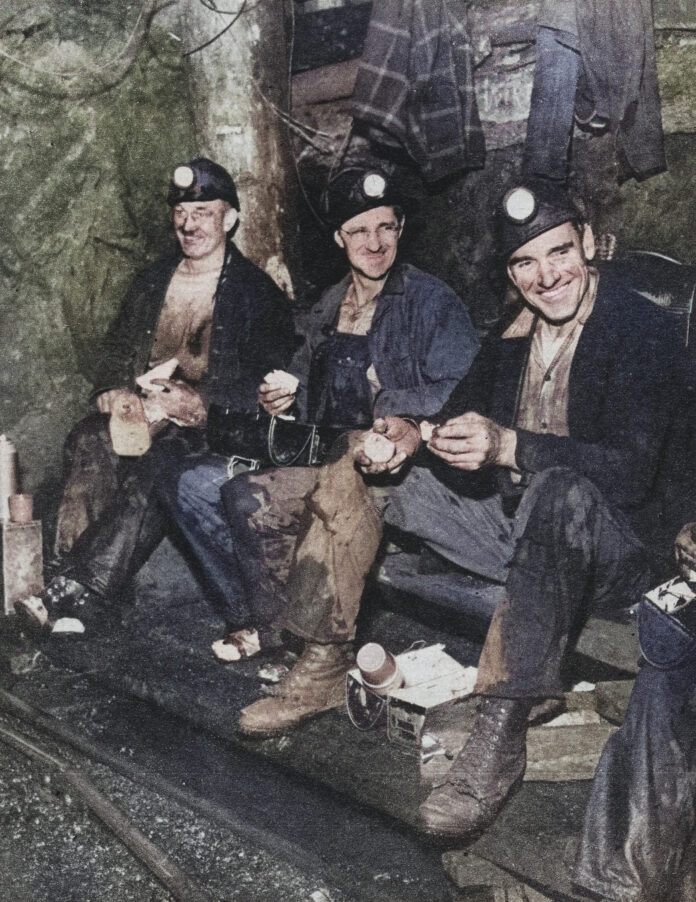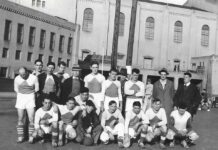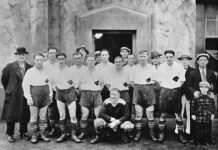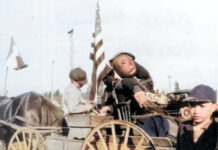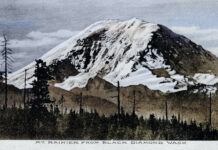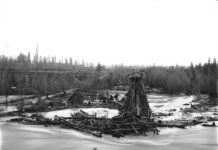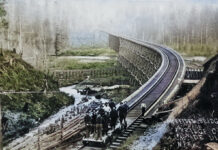Coal mining was a dangerous occupation. During the first 50 years of the 20th century, nearly 100,000 coal miners died in accidents. During a typical year before 1950, one out of every 340 coal miners perished. Perhaps only the logging claimed more lives, but records for that industry were poorly kept.
In February 1953, three coal miners were captured eating their lunch 500 feet below ground at the Landsburg mine in Ravensdale. Seated from left to right are: Charles McAllister of Buckley, a section foreman, Harry J. English, and Frank Stebly of Black Diamond. Within two years of this photo, two of these miners would be forever buried in this very mine.
The Landsburg mine had opened in 1941 along the Summit-Landsburg Road. By 1953, the mine was penetrated by a portal opening just north of Kent Kangley Road. The Landsburg No. 1 bed averaged 18 feet in thickness. Two other parallel seams, known as the six-foot and eight-foot beds were connected to the No. 1 working by rock tunnels. The coal beds dipped 80 degrees from horizontal, meaning they were nearly perpendicular to the surface. The mine typically employed 35 to 40 men underground with three on the surface. It operated three shifts per day, five days a week. Daily average production was 200 tons.
On Wednesday morning, January 6, 1954, at 10:40 a.m., Harry English was working with his partner, Roy Coutts 500 feet underground. There were in the counter gangway about 50 feet above where coal was loaded on rail cars to be hoisted up a sloped entry to storage bunkers on the surface. Without warning the ground where they stood suddenly collapsed. A brow of coal broke off the hanging wall and Coutts fell a considerable distance on a wave of loose coal, rock, and timbers. He was rescued four hours later suffering a broken wrist, severe bruises, and cuts over the face and body.
Efforts to find Harry English, age 40 began immediately after the recovery of Roy Coutts. Fellow miners worked day and night under dangerous conditions and utilized novel techniques in the rescue attempt. After eight days of grueling work, an investigating party consisting of Sam Nichols, President of United Mine Workers of America, District 10, Albert Donati, President of Local No. 6481, Clarence Holmes, Chief Coal Mine Inspector, company officials and U.S Bureau of Mines representative agreed to suspend efforts. Frank Stebly, the miners’ Safety Committeeman concurred in the recommendation.
Harry English’s body was never recovered. The death left his widow, Lily English alone to raise two sons, James English, 16, and Jerry English, 12. An acre of land above the site was offered by Palmer Coking Coal Co. for a memorial site, but three months later Lily English abandoned her initial plan and a lighted cross was placed in the Black Diamond Presbyterian Church instead.
Less than a year later, in the early morning of January 29, 1955, Elmer Ranta, the Landsburg mine’s night watchman the hoist signal’s continual ring. He tried to reach the four miners working underground but failed. Something was wrong. When the morning shift entered the mine at 6 a.m., they found the mine’s lowest level inundated with debris and water. A cave-in from the surface measuring 40 to 50 feet across and 70 to 100 feet deep, filled the Landsburg mine’s lowest level with thousands of cubic yards of mud and debris. Nathan D. Russell, age 48, Louis Vaiente, 58, John Kovash, 44, and Frank Stebly, 58 were entombed in the morass. There was absolutely no chance of recovering their bodies.
Frank Steblaj was born in Zapotok, Slovenia to Johann and Rose Steblaj on Oct. 4, 1896. He immigrated to the U.S. in 1913 at age 17, and shortly thereafter moved to Black Diamond. Frank soon anglicized his name to Stebly. He initially lived with Louis Breznik, who provided room and board for single miners. Frank married Josephine, Zavolosek in Chehalis in 1921, and the couple raised three children, Frank Jr., Annabelle (Saario), and John Stebly. Josephine died during surgery in 1948, and four years later Frank Sr. remarried Selma Constance Paul.
Several weeks later a memorial service for the four fallen miners was held near the mouth of the mine attended by an estimated 500 mourners. Mrs. Lily English, widow of Harry whose body was entombed underground a year earlier, sang in the choir during the Saturday service. Four memorial markers encased in concrete, one for each miner, were dedicated a short distance away under a grove of trees.
This photo was colorized by Doug ‘Boomer’ Burnham, a Tahoma High School photography instructor. It originally appeared on page 9 of the Feb. 22, 1953, Sunday Pictoral magazine under a story titled “Coal mining industry continues its slow decline in State of Washington” that featured Palmer Coking Coal Company’s Landsburg operation located about three miles north of its Black Diamond headquarters. Dennis Stebly provided biographical details about Frank Stebly. Dennis was 19 months old when his grandfather died.

